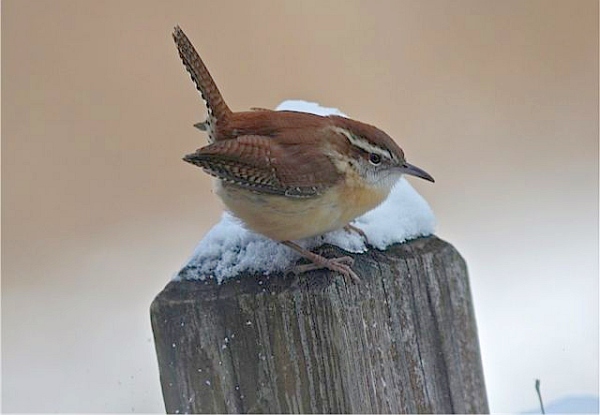
A hundred years ago Carolina wrens (Thryothorus ludovicianus) were a southern bird rarely found in southwestern Pennsylvania but they expanded northward during the 20th century, even into Canada.
Carolina wrens don’t migrate so they have to cope with winter wherever they settle down. When winters are severe they die off and are rarely seen until new individuals disperse northward to fill the gaps. This was particularly noticeable after the harsh winter of 1977-78 when it took them ten years to recover their northern haunts.
Since then they’ve done quite well, a success due in part to human changes to the landscape. Warmer winters, regrown woodlots, and backyard bird feeders all make it easier for Carolina wrens to survive though it wouldn’t have been possible without a change on their part, too. In 1912 Dr. Frank Chapman considered them to be woodland birds unadaptable to human settings but by 1948 Arthur Bent observed that there was plenty of evidence they’d made the change. Indeed we see them near our homes every day.
This winter may be a tough challenge for Carolina wrens. During the polar vortex January 6-7 many birders were concerned that their favorite wrens would perish. We were happily surprised that they came through, sometimes by hiding in our buildings, during the two-day cold snap.
This week will bring another, longer round of arctic cold with temperatures down to 0oF. Will our wrens make it through this time?
Fill your feeders and cross your fingers. May our Carolina wrens be winter-hardy, greeting us with their loud calls and songs when the weather warms again.
(photo by Marcy Cunkelman)
Several winters ago, I was thrilled to find a pair of tiny, dark wrens scavenging amongst my annual flowers on the patio that had gone to seed. I had never encountered winter wrens before, and found them irresistibly whimsical, with their jaunty stub tails and peeping voices. These two seemed to be so tired from their journey South, they let me stand within a few feet and watch them for 15 minutes.
I had another fascinating experience a few weeks ago, calling one out of a brush pile along Chartiers Creek. They are shy, but also curious, with patience. Still quite different from the Carolina wrens, who make themselves know, buzzing among the lower branches of Catalpa trees on this same site.
So, what is it that makes winter wrens so much more adaptable to extreme cold…their smaller size?
Carolyn, The interesting thing about winter wrens is that they *do* migrate. They nest in the north so we only see them in winter here. They avoid the bitter weather and don’t arrive on their breeding grounds until April or May. Perhaps they’ll move further south when the weather gets bad. Birds such as robins do that.
I got to see my lifer Carolina Wren in Sharpsburg while visiting friends at Christmas. I looked out at the feeder and there it was, chowing down.
http://www.flickr.com/photos/steve_valasek/11707024755/in/photostream/
And I’m pretty sure that I used to work with Dick Nugent at PPG. Small world.
Thanks, Kate, for the heads up. I made sure that all my feeders are full for the upcoming cold spell. Right after the last cold snap, I spotted one of these little birds come out of a pile of kindling that we store in an old, unused brick barbecue. It sunned itself at the edge of the opening. I often wonder about how our backyard wildlife copes with cold snaps, so it was a very pleasant surprise to find that we were providing shelter without even knowing it.
Thank you Kate! I have a beautiful couple of Carolina wrens who are back for a second winter. They’ve been holding up well and hide under my patio furniture to stay shielded from the weather between visits to the bird feeder. Any other suggestions on how to create a more friendly backyard area for them during cold temps?
Elizabeth P,
Here’s a blog post by Carole Sevilla Brown (in Philadelphia) with many suggestions for winter birds’ shelter
http://nativeplantwildlifegarden.com/birds-in-the-winter-wildlife-garden/